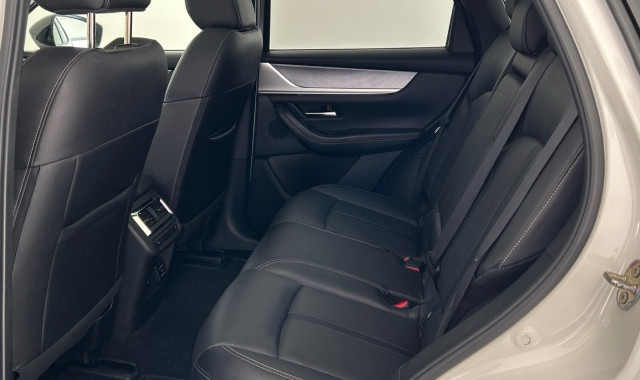Test MAZDA CX-60 2.5 l e-Skyactiv PHEV Homura 241 kW
- Jan 11
- 8 min read

We got to test a plug-in hybrid from Mazda, the CX-60 model in the Homura trim, including the Comfort, Comfort & Sound, Safety and Panoramic Sunroof packages. And what do we think of it? You will find out in the following lines.
We picked up the Mazda in white metallic, on 20" matte black "balloons" and accessories in matte black when the first December snow began to fall on the Czech Republic. Well, at least we'll try out its behavior in a winter environment, right? The Mazda CX-60 was the top of the Japanese manufacturer's offer until the manufacturer announced the arrival of the CX-80 on the market. Its competitors include the Hyundai Santa Fe, Kia Sorento or the premium Audi Q5, Mercedes-Benz GLC, BMW X3 or Volvo XC-60. If you look at the price list, you'll find that compared to the aforementioned competition, it is one of the cheapest and even the basic version will offer you a lot of equipment, safety and assistance systems and a really nice exterior and interior design.
Mazda has always gone a bit against the grain. It started using the Wankel engine in its vehicles, and when all manufacturers started installing turbochargers in their vehicles, Mazda threw itself into the development and production of naturally aspirated engines. The highlight of their production is the Skyactive-X petrol engine, which works on the principle of a diesel engine. The Japanese do not simply follow established trends, but go their own way. No downsizing "engines", but proper high-volume six-cylinder engines, into which you can pour both petrol and diesel as you choose. In the case of the CX-60, however, it made an exception for the European Union so as not to be labeled a heretic right from the start, and also introduced an ecological version with a plug-in hybrid power unit under the hood. According to the tables, it should therefore also be environmentally friendly. This version consists of a 2.5-liter petrol four-cylinder, an electric motor on the rear axle and a 17.8kWh battery. The total output of the hybrid system is a solid 241 kW (327 hp). According to the manufacturer, the range on pure electric power is approximately 65 kilometers.
Mazda has basically four trim levels prepared for the CX-60 - Prome Line, Exclusive Line, Homura and Takumi , which means that we had the second highest trim level available. The interior "hugs" you nicely after you sit down, the quality of workmanship and the materials used can be described as truly premium. The driver's cockpit has intuitive control elements, Mazda as such does not follow the trend of "digitalizing everything", so all important functions and switches for setting the radio or ventilation have remained in the good old button form. The display and infotainment itself are also carried in the spirit of simplicity. Simply Mazda as we know it. Although, the entire infotainment and its controls reminded us a bit of the controls of the BMW X5 from the F15 version (2013-2019), but maybe it just seems that way to us. The cabin is spacious even for taller people, it just seemed to us that there was a little less space in the back seats. If you are a toy and after getting the vehicle you sit in front of the garage in the car and adjust and customize it, Mazda will certainly make you happy, you can beautifully "personalize" the CX-60, when after entering your "dimensions" it will set the right position for you and if you show it according to the instructions from all profiles as in the police records, then when you get into the car the dash camera will read you and set everything according to you. This has its advantages when your car is used by more than one person in the family, that it recognizes who got in as the driver. And if Mazda does not recognize you after all, after starting it, you just choose your profile and it will immediately react and set everything correctly.
Another plus is the MAZDA mobile application, thanks to which you can manage any vehicle charging, but also the fact that in the morning you will feel like in a room in the CX-60, you will not have frozen windows and there will be a heated seat and steering wheel waiting for you. And if you are going on a longer route, you can prepare it in the comfort of your home, send everything to the Mazda navigation and set off. If you use one of the navigation mobile applications, you can connect wirelessly to both Apple CarPlay and Android Auto without any problems and store your phone in the compartment, where it will be charged wirelessly. The only problem we had was with the assistant settings, but like any ordinary mortal we refused help and fortunately Mazda has one magic button to the left of the steering wheel, which you can turn off some of those annoying assistants.
The vehicle has quite a lot of storage space, you can charge it via USB-C, and the trunk has a sufficient 570 liters, which will be enough for trips and vacations.
As we mentioned at the beginning, we picked up the Cé-Ix 60 in winter weather, on winter tires, so we could expect higher consumption of both fuel and electricity. We admit that although we are all supporters of large engines (from six cylinders upwards) in the company, we like the combination of large atmospheric engines and electric doping. Toyota (and of course Lexus), but also Ford have already started to prove that a turbo is not needed, because at low speeds, where the atmosphere loses its dynamics, electricity will help with immediate onset. In the case of the Mazda test vehicle, however, we were a little, perhaps more, disappointed. It seemed to us that the interplay of the engine, electric motor and eight-speed gearbox was quite sluggish, sometimes we felt as if the car did not know which drive to use at given moments. We even got the impression a few times that after the engine was started, nothing happened for a while, as if the control unit was still "thinking" what it actually wanted to do. Behind the scenes, we learned that Mazda is aware of the problem and is working on a SW upgrade for the control unit.
Another surprise for us was driving on the highway, when using the adaptive cruise control, when the CX-60, instead of using its enormous power, started to downshift furiously, just to accelerate even by 10 km/h. We admit that at that moment it is quite an unpleasant thing, because you get the first kick when downshifting, when the car slows down slightly and the second when it accelerates brutally. Unfortunately, this also happens on a slight climb, when the CX-60 suddenly thinks that it needs to downshift by two gears and with the engine roaring at high revs, it overcomes those 100 meters to engage eighth gear again, which of course has a negative impact on consumption. On the other hand, if you enjoy driving with the adaptive cruise control, working with it in the Mazda is pleasant. Along with reading the signs, it always presets the speed shown on the driver's display, which you just confirm by pressing the cruise control knob and the CX-60 takes care of everything. If you have set a higher "strength" of recuperation, it brakes with this, which is reflected in the battery capacity, which is also reflected when driving downhill, when you can see that you are constantly recuperating while maintaining a constant speed. Another positive is that even if you set the smallest distance on the cruise control, Mazda does not brake at the last moment behind the car, as some premium brands do, but it really slows down smoothly, so that your hair does not stand up in horror and you do not slam on the brake in fear, thinking that the car should already be braking and it is still "flying". And from personal experience, we will just add that while traveling from Prague to the Beskydy Mountains, we did not need to step on the gas or brake pedal once on the D1, we really did everything by simply confirming the preset speed and possibly increasing it above the permitted speed within the permitted, or rather tolerated, deviation.
Before we get to the final "how much does it drive for", let's talk about the driving characteristics. The CX-6Oka's steering is surprisingly precise. The brakes, thanks to the aforementioned energy recuperation, are precise and well dosed despite the car's weight of slightly over two tons. If you learn to work well with the aforementioned recuperation and over time start to estimate its onset and deceleration from given speeds, you will find that in most cases you don't even need to use the brakes. But it really takes a lot of foresight and "reading" the traffic.
Mazda claims that its cars are not just a means of transportation, but that they should also entertain their owners and bring them a unique driving experience. Unfortunately, the CX-60's chassis settings were a bit off. On poor-quality roads, this Mazda is hard, slightly jumpy, and sometimes we felt that the Mazda was unable to filter larger irregularities. We cannot judge how much the large wheels with low-profile tires did, but we know that other colleagues also complained about the "hardness" of this vehicle in their editorial tests. Which is a real shame, because otherwise on good roads and even "twisted" sections we really enjoyed the CX-60. Despite the stated weight, it takes turns accurately, without unnecessary leaning, no feeling of understeer, on the contrary, on accelerated exits, the rear was nicely balanced and often had a tendency to overtake the front. So when the Mazda CX-60 gets a facelift, we would advocate focusing on the chassis. Unfortunately, not everywhere are beautiful and "healthy" roads.
And now finally to the consumption. We have driven about 2,500 km with the Mazda CX-60 PHEV so far. For the first 14 days, we used the vehicle purely in Prague and its surroundings, when the range was about 60 km. We always charged the Mazda from a socket overnight, and in the morning, depending on the weather, we always "warmed it up". After 14 days of operation, the consumption was 1.0l/100km and the consumption was about 24 kW/h. We then fully charged the CX-60 and set off on a trip to the Beskydy Mountains, where we no longer charged and basically used the battery purely for recuperation. At that time, the temperature ranged from -3 to -9, and when we returned, it gradually warmed up towards Prague to 10 degrees. Total consumption after 1,150 km (800 km of highway, 350 km of county roads, driving around villages) stopped at 6.7l/100km and 31 kW/h. Of course, constantly heated seats, steering wheel and 21.5 degrees in the cabin.
After returning from the Beskydy Mountains, we did not reset the indicators and after another approx. 500 km around Prague and the surrounding area, the average dropped to 2.5l/100km and 26kW/h. Everything at the limit of permitted speeds + 10% deviation above and beyond approx. 30km, when the acceleration was tested. For us, pleasant!
And what about the conclusion? The Mazda CX-60 PHEV is a beautifully designed car, with a luxuriously crafted interior. With its length of 4,745 mm and width of 2,134 mm, it is already among the larger SUVs that will provide you with a lot of luxury, comfort (except for the chassis) and, in the case of this hybrid variant, also pleasant costs for a pleasant price. It should be added that you will also get EL signs on the Mazda CX-60 PHEV, so this will bring you further savings in the form of parking and possibly highway vignettes. But let's not just praise, there are two negatives against purchasing it, one of which will hopefully be removed in time. These are the "cooperation" of the drivetrains and the hardness of the shock absorbers, which Mazda will probably also catch on to over time. Either way, we enjoyed the Mazda and if we count all the pros and cons, in this segment we would 85% choose the CX-60. If only because the "Japanese" are known to be big holders.
Soon you will be able to watch the test of the Mazda CX-60 PHEV performed by our young and adventurous duo Barča and Domča and their "Rozjeď to" on our FlexiDrive Invest Media YouTube channel and social networks!
The vehicle was loaned for the test

FlexiDrive Invest as recommends and was used in this vehicle:













Comments